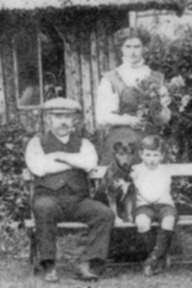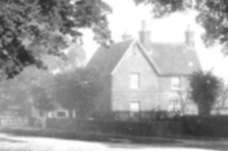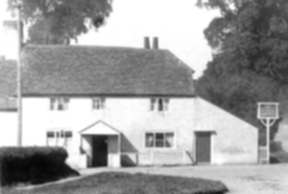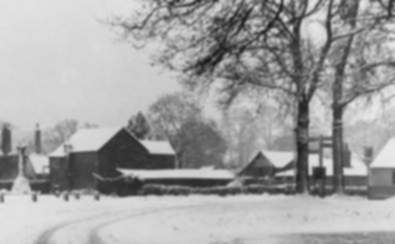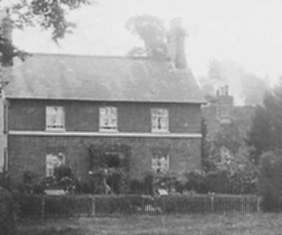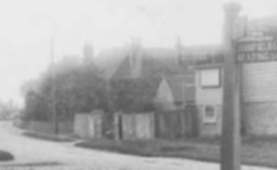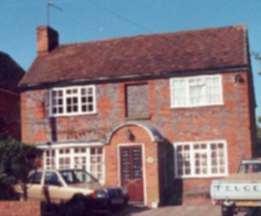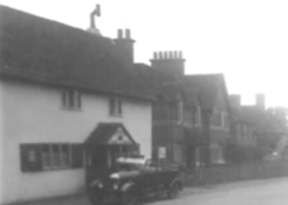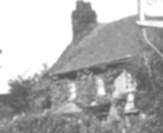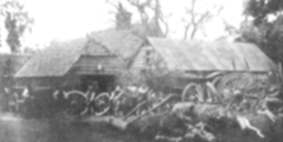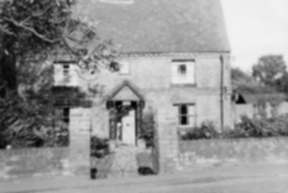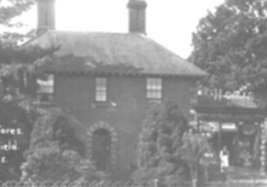
|
Arborfield
|
|
Memories
Related sites:
|
Meet me outside Newlands Farm at about five minutes to eight. The sun is shining, the birds singing and faintly in the distance you can hear the chatter of a mowing machine cutting the grass to make hay (the tail grass always cuts cleaner while the morning dew is still about). Listen, if the wind is in the right direction we shall hear: dong, dong, dong, dong, eight times. This is the clock at Arborfield Hall striking eight; the man looking over the fence in the farmyard is Mr Charlie Lucas. He is checking his watch, as will most of the locals, for Arborfield Hall clock keeps very accurate time. Mr Lucas has just fed a dozen fine young bullocks in the stockyard that he is fattening for the Fatstock Market in Reading just before Christmas. There is very little activity in the farmyard, as most of the farmhands have been working in the fields for nearly an hour already.
Before we come to the main road, there is, on the right-hand side, a triangle of grass where there are two horse chestnuts and one very large oak tree. On the three sides of the triangle there are hard surfaced gravel roads.
Opposite the "Bull" there is a
single storey building, which contains almshouses, property of the Parish
Council. The one on the right is occupied by an elderly widow, Mrs Love, and the
one next door, by Polly Lunn (a local character) and her elderly brother,
Alfred. Both are simple folk, but with odd jobs they do within the village and
some assistance from the Board of Guardians, they always appear clean and tidy.
Now back to the other side of
the street. There are two cottages adjoining the Garretts' house; one is
occupied by Mr and Mrs Alexander. Mr Alexander could be just coming out of his
gate wheeling a bicycle, dressed in a smart green uniform with peaked hat and a
black band over his left shoulder across his back and under his right arm - like
a bandolier with a small oblong pack
Now we are outside the last cottage of the block. Here lives Mr and Mrs William Cox and their young son, Young Willie Cox, Arborfield's first telegraph boy, with his new red bicycle. He will deliver telegrams from Arborfield Cross Post Office over a wide area - Farley Hill, Bearwood and Sindlesham, Barkham and as far as West Court on the Eversley Road. His father works for the Garrett Brothers and is also the Sexton at Arborfield Church. As Garretts are the Undertakers, this works very well, as the Sexton is required to toll the knell when there is a death in the parish, and to dig the grave and complete the task after the funeral service.
Across the road is a footpath that goes past three cottages to School Road. The first is occupied by the Mabett family; Mr Mabett is a chauffeur to Mr John Simonds. Next-door Mr and Mrs Chambers, Edward (or Teddy as he is generally known), is a carpenter, a skilled craftsman working for the Garrett brothers. Any carpentry completed by Teddy is a work of art, perfect in every detail. He is also a member of the Cricket Club - a very safe pair of hands behind the wicket. Next door again, live Mr and Mrs Charlie Selwood and Charles their son, known to everyone as Sammy. Both men work for Mr Lucas.
Opposite are the two cottages built about twenty years ago by George Garrett; they are tied cottages for the employees of Newlands Farm, Mr Hall in one and the other awaiting a new tenant.
From time to time a travelling 'Cheap Jack' sets up his booth in the yard, selling pots and pans, china and crockery, cutlery, cut throat razors, boot and shoe laces, and a hundred and one other household requirements. For the children there are dolls, toys and a very sticky toffee, which we call 'stick-jaw', aniseed balls and butterscotch. At night his display is illuminated with two paraffin oil flares and that, with his cries of "Walk up, walk up, ladies and gentlemen!" makes quite a gay setting to the "Swan". You will have noticed many
schoolchildren crossing the green opposite, going by the footpath across Mr
Isaacs' field to school. They have come from many different directions, some
even from Farley Hill and Maggs Green, and some whose parents are poorly paid,
wearing wooden soled clogs. These wear wonderfully well and easy for Dad to
repair. All will be wearing satchels or if there is more than one in the family,
the eldest will be in charge and wearing the satchel containing their dinner. It
is not uncommon for some children to have eaten their food before getting to
school, as hunger was well known in large families.
Now to the Wheelwright's workshop on the left hand side of the street belonging to my father, George Bentley, known to his fellow members of the Cricket club as 'Chummy'. He has been a bell ringer with the Garrett Brothers and others, following their fathers, when the new church was built in 1863. The Wheelwright's business has belonged to our family for many years; there is no record of when the business first started, but it was known that the Bentleys had lived there well before 1800. In the late 1800's the business was carried on by Mr William Vincent, coachbuilder, who later was the founder of 'Vincent's of Reading' in Castle Street. It was returned to my father in 1903. If you look through the large double doors you would see farm cart or wagon being made or repaired, milk floats, wheelbarrows, and ladders and many other implements for an estate or farm in the surrounding district. Each item or vehicle was given a primary coat of paint before being put in the paint shop for its second and final coat of paint and a final coat of varnish. If you listen you will hear Alfred Attwood in the Blacksmith's shop at the back of the workshop making all the ironwork required for whatever is being made in the Wheelwright's shop. (Before Alfred, the Blacksmith was William Harding who has worked there since boyhood and is now in his eighties. He could neither read nor write but his skill with ironwork was wonderful). Like all Blacksmiths he wears a leather apron to prevent the sparks from the red and often white hot iron burning his clothes. Mr Charlie Cox is the Wheelwright, a very gentle man but skilled and industrious, a perfect timekeeper, never a minute early or late.
Before the advent of the steam driven saw, the timber was sawn by hand in the saw pit in the yard, with a huge crosscut saw - one man at the top and one in the pit below; a very uncomfortable place to be in hot weather.
The footpath next to the shop crosses the field to Arborfield Court and through to Wokingham Lane and Farley Hill. Mrs Bruce lives in the Court, only recently built and completed in 1906. In the summer time the walk across the fields is very popular and pleasant. On Sunday evenings it is possible to see several families going for a pleasant stroll through the woods to Farley Hill Church. If you stand by the pond in the corner of the field next to the gate, on fine evenings you may hear music, either a brass band or someone playing a musical instrument, or singing a well-known song. The sound is produced by a gramophone in the cottage across the footpath; it belongs to Mr and Mrs Harrington. This is the first gramophone that many village folk have ever heard and the records are cylindrical. It has a huge horn and when played by the open window the sound can be heard distinctly in the village.
Now we have "Peacock Cottage", the only thatched cottage in the village street. In the garden is a yew tree clipped in the shape of a peacock. It is one of the oldest dwellings in the district with a wooden frame. Some of the walls are wattle and daub and what brickwork there is has been hand-made as the bricks vary in shape and size. There is a cellar beneath the bedroom with a spring in the corner, which obviously is connected to the "Whitewell". The District Nurse lives here, she is a widow, Mrs Hogg, with two children and she does her rounds on a bicycle. Looking at the surface of the road, there are several damp patches and there is a trickle of water running down the verge of the road. This comes from the spring in the bank; including the "Whitewell" there are several active springs here. It is a local belief that if we are due for a spell of fine weather the springs are more active. On the right hand side, situated on the bank, there is a danger sign. On an iron stake with a red triangle at the top, and beneath on iron plate with the words "WARNING - PLEASE DRIVE SLOWLY THROUGH THE VILLAGE". Quite frequently a horse and cart pass at quite a sharp gallop and several motorcars may go through during the course of the day, leaving a cloud of dust, blown up from the gravel road. There are no footpaths either side of the road for the full length of the village street. On the left hand side on the bank for about 100 yards there are several very large elm trees. The field over this bank is known as "Jagletts". We are now at the top of the hill, the highest point of the village street. During the summer holidays Mr Seymour allows us children to fly our kites from the field on the right; both home-made kites and those purchased in Reading or Wokingham, can be seen high in the sky towards the "Coombes". The prevailing wind is usually from the east and many a penny ball of string has been purchased from the shop for the larger kites that fly quite high and a considerable distance away according to the strength of the wind. Our stroll through the village has taken nearly an hour. At nine o'clock the school bell will ring and if you listen you will hear clip, clop, clip, clop, the sound of horses hooves and iron tyres on the gravel road. These are the milk floats returning from Wokingham Station to the local farms. The milk from last evening and this morning's milking have been taken in seventeen-gallon churns to the station and is now half way to London on the "Milk Train". From this spot in the winter on frosty mornings one can hear the trains shunting about in the Wokingham Goods yard at the station. Should the wind be in the east it is possible to hear the empty milk churns being unloaded on the platform, and the trains on their run between Sindlesham Halt and Wokingham. We now near the end of the "Village Street", just down the hill are a pair of cottages built for Mr Hart at the shop. Mr Hart was the first village baker in about the 1880's. He delivered the newly baked bread through the district carrying the bread in two large baskets, which he carried on his arm. The cottages are occupied by Mr Tom Edwards, an employee at the Remount Depot. Next door lived Mr and Mrs John Humphries and he is the "Road Man". Heaps of gravel are put at convenient places by the road from the Parish boundary between Shinfield and Arborfield to the Farley Hill turning on the Eversley Road, and John with his wheelbarrow, pickaxe, shovel and hammer, repairs the pot holes as they appear throughout the village. Mrs Humphries is one of the wonderful women who are found in villages throughout England, taking in washing, acting as midwife and nurse (before the arrival of Mrs Hogg) and also there when there is a death in the village to comfort the bereaved and to do the laying out. She can be seen going from one of her many 'good deeds' always wearing a spotlessly white pinafore and carrying under her arm the tools for whichever task she had or was about to perform. Opposite to Harts Cottages is the chapel - Arborfield Free Church, with its stable and coach house at the back. The preacher usually comes from Reading in a pony and trap. Several locals often take both the morning and evening services. There is always a good attendance, and on Sundays when the weather is warm enough the windows are open wide and the vocal effect of both the preacher and congregation can be heard for some distance away. One evening during the week there is 'Band of Hope' for the younger generation. Notes: Many surnames listed in this article are now commemorated in street names on the Penrose Park estate. Others (e.g. Emblen, Anderson, Hart) are found in the centre of the village. If you have any other photographs we could use to illustrate this article (e.g. the front of the wheelwright's shop, the Free Church or the fields now occupied by the Link Way estate and Hillcrest), please contact us. Also, how about someone describing a stroll through the village in the 1940's, or the late 1950's immediately prior to the building of Link Way?
|
||
|
Any Feedback or comments on this website? Please e-mail the webmaster |
